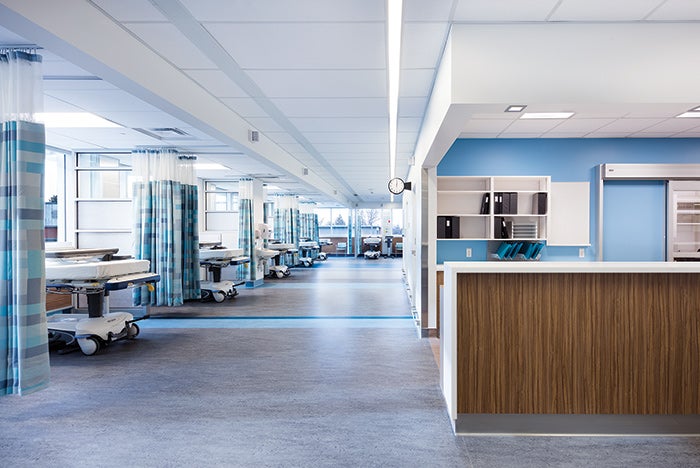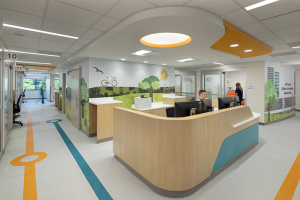Furnishings and materials to aid infection prevention
Interior furnishings and materials can play an important role in maintaining the clean appearance of a health facility and preventing the spread of infection.
While there is no substitute for good handwashing when it comes to infection control, a health care organization can incorporate furnishings and materials into its overall infection prevention program by “making [furniture] selections that don’t contribute to the challenges of keeping a really clean environment,” says Peggy Sonnenburg, director of marketing and product management, Nemschoff Inc., Sheboygan, Wis.
Design and materials
Nemschoff, the health care furniture company of Herman Miller Inc., Zeeland, Mich., takes a two-pronged approach to creating cleanable furnishings, says Sonnenburg. “It’s both in the way we approach product design and in what we use, in terms of materials,” she says.
The company’s Ava recliner, for example, is designed with open-loop arms and covered casters that prevent the collection of debris. “There’s almost no space within this product for things to gather and hide. It’s just designed to optimize cleanability,” Sonnenburg says.
Nemschoff’s Palisade collection features clean lines, with no crevices where material can collect. The Palisade sleep sofa has a wide clean-out gap between the seat and back for easy cleaning. As a standard option, Palisade products can be ordered with solid surface arm caps, “which are highly durable, highly cleanable and becoming more and more in demand in health care environments,” says Sonnenburg.
“The types of cleaners and solutions that are used within health care — they’re fairly rough and abrasive on materials,” she notes. For furnishings to achieve the durability needed for health care environments, their materials must be able to withstand hospital-grade cleaning protocols and chemicals.
You may also like |
| Materials for cleanability and germ resistance |
| Trends in health care furniture |
| Enhancing infection prevention in the patient environment |
|
|
“For a surface to be disinfected, it has to be cleaned first,” explains Mark Krejchi, health care industry manager for engineered surface manufacturer Wilsonart, Austin, Texas. To ensure that Wilsonart’s line of high-pressure laminate, quartz, solid-surface and other interior surface options can be cleaned and disinfected to health care standards, the company focuses on what Krejchi calls the three D’s of materials selection: disinfectability, durability and design. Products must be able to withstand disinfection chemicals and technology, durable enough to prevent cracks and chips that make a surface hard to clean, and designed to promote a healthful aesthetic.
“The aesthetics of a space is important not only to the mental framework of the staff who work in a space, but there is good science to indicate the environment plays a really important role in the healing process,” Krejchi says.
The Wilsonart line includes the EOScu Preventive|Biocidal Surface, a copper-enhanced material that has been shown to kill greater than 99.9 percent of Gram-negative and Gram-positive bacteria within two hours of exposure and is registered with the Environmental Protection Agency (EPA) for public health claims. “A surface that self-sanitizes can be a very valuable asset in a space where the manpower to maintain and disinfect surfaces is challenging,” says Krejchi.
Wilsonart’s Re-cover product features an adhesive backing that allows health facilities to update the design of existing laminate surfaces without removing casework or using contact adhesive. “There’s no smell associated with it. You just peel it, stick it on and move on,” Krejchi says. “It’s a valuable way to take a material that’s traditionally not renewable and refresh the look at a really affordable price.”
Positive impression
“A clean environment gives a positive impression,” says Amy DeVore, business development manager for the interior wall protection division at Construction Specialties Inc., Hughesville, Pa.
The company’s Acrovyn PVC-free wall and door protection products are impact-resistant and embedded with color throughout, so any scuffs or scrapes that occur in high-traffic areas won’t mar the appearance of the product. The low-profile texture of Acrovyn 4000 is designed for a contemporary look that can be cleaned with soap and water or strong disinfectants, as needed. The Acrovyn product line includes wall sheeting and panels, corner guards, crash rails, handrails and door-frame protection in solid colors, simulated woodgrain patterns, real woods and metals. “As the needs of the health facility have evolved, we’ve tried to evolve with it,” DeVore says.
Acrovyn by Design allows health care organizations to embed a photograph, logo, image or message behind the Acrovyn protective surface. Lehigh Valley Health Network, Allentown, Pa., recently installed this material to create colorful, large-scale nature murals in the health system’s pediatric departments. The murals provide positive distractions and serve as visual landmarks, says DeVore.
The JumpSeat Collection by Sedia Systems Inc., Chicago, is easily cleaned and can help to keep health care environments clutter-free. The JumpSeat Wall, the most popular JumpSeat product for health care, according to Sedia System’s marketing manager, Karen Andersen, is a low-profile, wall-mounted foldable chair.
The seat can support up to 600 pounds and is less than four inches deep when closed. It hangs six inches off the floor, making it easy to clean beneath. JumpSeat products’ wood finish can be cleaned with a diluted bleach solution and includes antimicrobial protection. The company offers a range of fabrics, PVC-free polyurethanes and silicone options that are antimicrobial, antibacterial and cleanable with bleach. Fabrics that protect against permanent stain, moisture, mildew and odor are available, as well.
“When it’s going to be in a health facility, whether it’s an emergency room, a patient room or a dental clinic, multiple people are going to be sitting in it every day, and facilities need to be able to clean it and clean it easily,” Andersen says.
“In health facilities, it’s all about the perception of clean,” says Tom Hume, market segment manager for commercial rubber flooring manufacturer nora systems Inc., Salem, N.H. He notes that the high-heat, high-pressure production system of nora’s vulcanized rubber flooring creates a dense, nonporous surface that closes even tighter over time, for excellent durability and easy cleaning.
The material does not promote mold or bacterial growth and can be cleaned with steam and a buffing solution or neutral cleaner, adds Jonna Gravitt, account manager, nora systems. The nora pro steamer is a compact machine that allows facilities to clean occupied spaces quickly and quietly, using steam produced from distilled water, which eliminates odor and volatile organic compounds.
“The health care environment should be healing and safe,” Gravitt says. Products that promote easy cleaning “contribute to a healthier environment for patients and staff.”
Amy Eagle is a freelance journalist based in Homewood, Ill., who specializes in health care-related topics. She is a regular contributer to Health Facilities Management.






